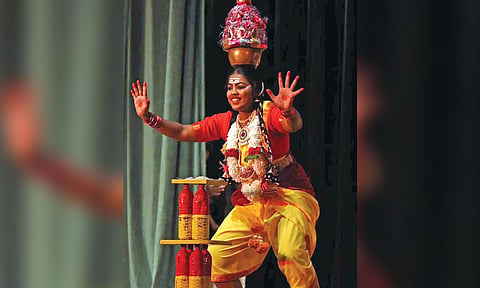

TIRUCHY: Come Chithirai, the temple festival season in Tamil Nadu, folk dance performers are normally busy with packed schedules and peak earnings.
But now, with the invasion of cinematic dance performances, the scenario has changed completely. It has also affected the livelihood of traditional folk artistes. This is the reality even during festival season. Around 4 lakh artistes from the state who had inherited the form of traditional performances have been relying on government support to survive and also to keep the rich art form of Tamil Nadu alive.
Tamil Nadu has a rich tradition of folk performing arts. These arts depict a variety of music, dance, and theatrical traditions and are often rooted in rural communities and religious festivals. It reflects the state's diverse cultural heritage.
There were around 1,000 art forms in Tamil Nadu, but currently one can witness only fewer than 20 art forms being performed across the state, especially in the districts like Tiruchy, Thanjavur, Ariyalur, Tiruvarur, Nagapattinam, Pudukkottai, Madurai, Theni, Tirunelveli, Villupuram, Cudalore and Sivagangai.
“Once these folk-art forms, particularly ‘Karagattam’ were venerated and the artistes had respect in the society. During the festival seasons, particularly in the Tamil months of Thai, Maasi, Panguni, Chithirai, Vaikasi and Aani, there were programmes which helped the artistes earn well for their livelihoods.” A Rajendran, honorary president of Tamil Nadu Gramiya Kalaignargal Nadana, Nayyandimelam Sangam and husband of ‘Kalaimamani’ Thenmozhi Rajendran, told DT Next.
“However, today, the organisers have started ignoring the traditional forms and have started opting for cinematic dance performances, which are laced with vulgarity. The traditionally trained performers who never yield to such demands are forced to sit in the houses struggling to run their families, he added.
Though there is a regulation by the state government on performing folk arts, the organisers and bigwigs from the localities opt for the cinematic dance performance.
“Since ‘Karagattam’ has also changed, the traditionally trained performers are affected as they never negotiate their performances for the sake of organisers and so many of them particularly, the artistes above 30 years have preferred to work as construction labourers and agricultural coolies for ensuring their daily bread,” Rajendran said.
While Thenmozhi Rajendran said that the number of students opting to learn ‘Karagattam’ had been declining year by year, as the demand from the organisers had gone extremely weird. “So the girl children opt to learn ‘Bharatanatyam’ rather than ‘Karagattam’, she said.
True to the claim, the Thenmozhi Rajendran couple are running a ‘Karagattam’ training centre in Thanjavur, which has only a handpicked student.
“The parents hesitate to send their children to get trained in ‘Karagattam’. To enliven the art, the state government should organise training camps in every district, and senior artistes can be selected for teaching the art and ensure performances in every government function,” Thenmozhi said.
Meanwhile, K Palaniswamy, a researcher of folk arts, said that the folk artistes are living in a deprived condition and their standard of living is largely determined by the folk art that they are performing and so the state government should pay a special attention to all festivals by giving folk artists ample opportunities and improving them in the economic environment.
“Families who are well-versed in teaching folk arts should be appointed as teachers in the Tamil Nadu Government schools and colleges to teach folk to students, and lessons on the folk arts should be included in textbooks,” he added.